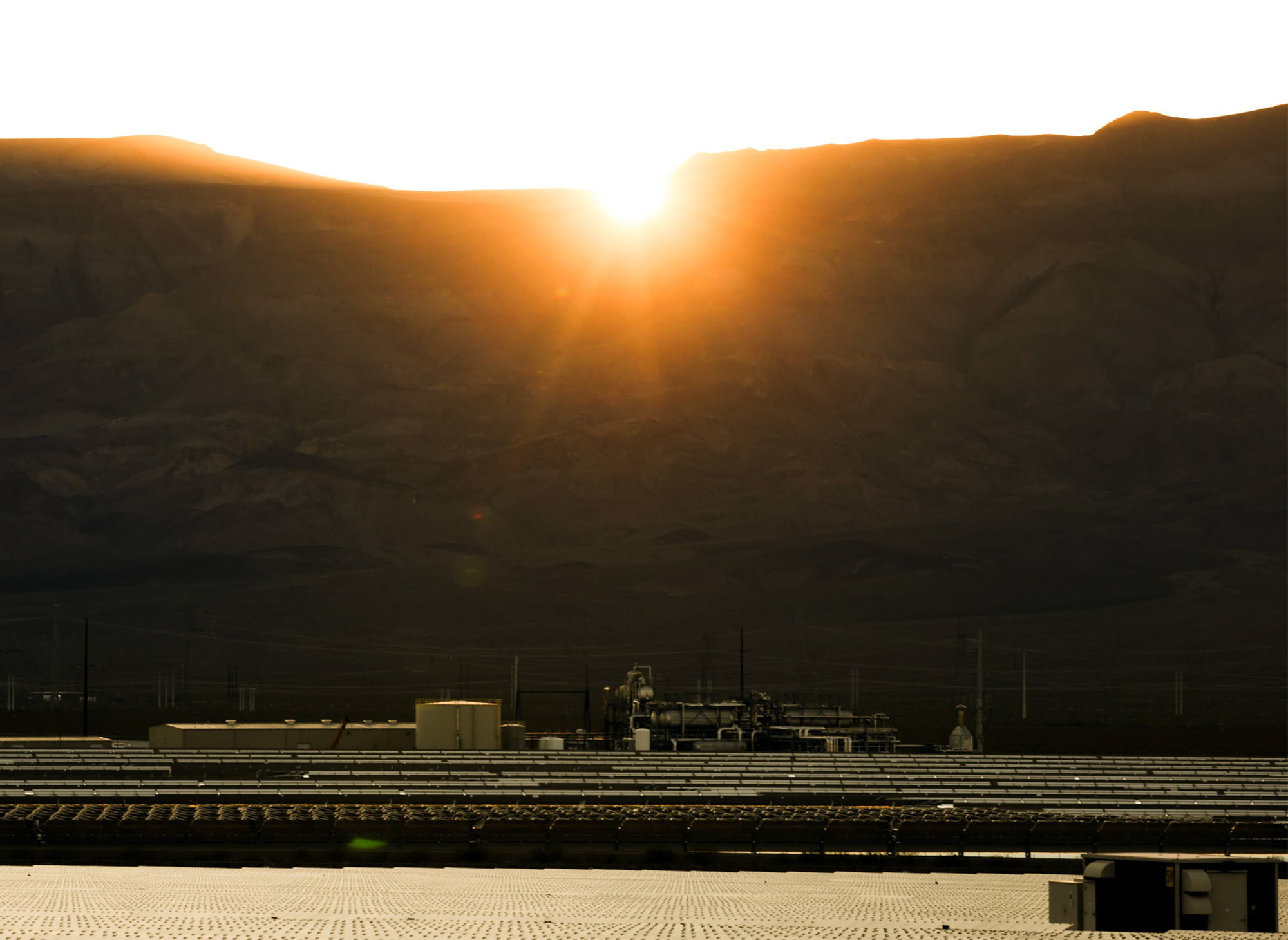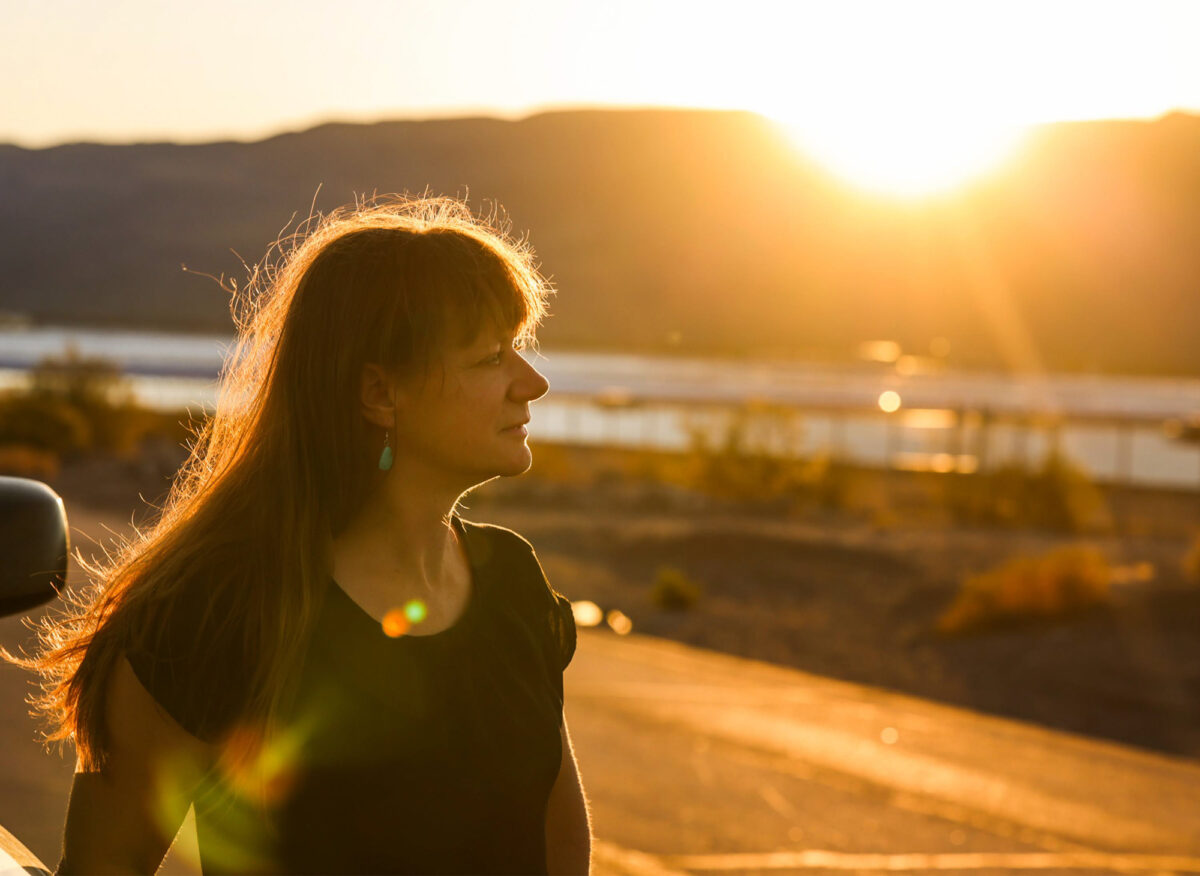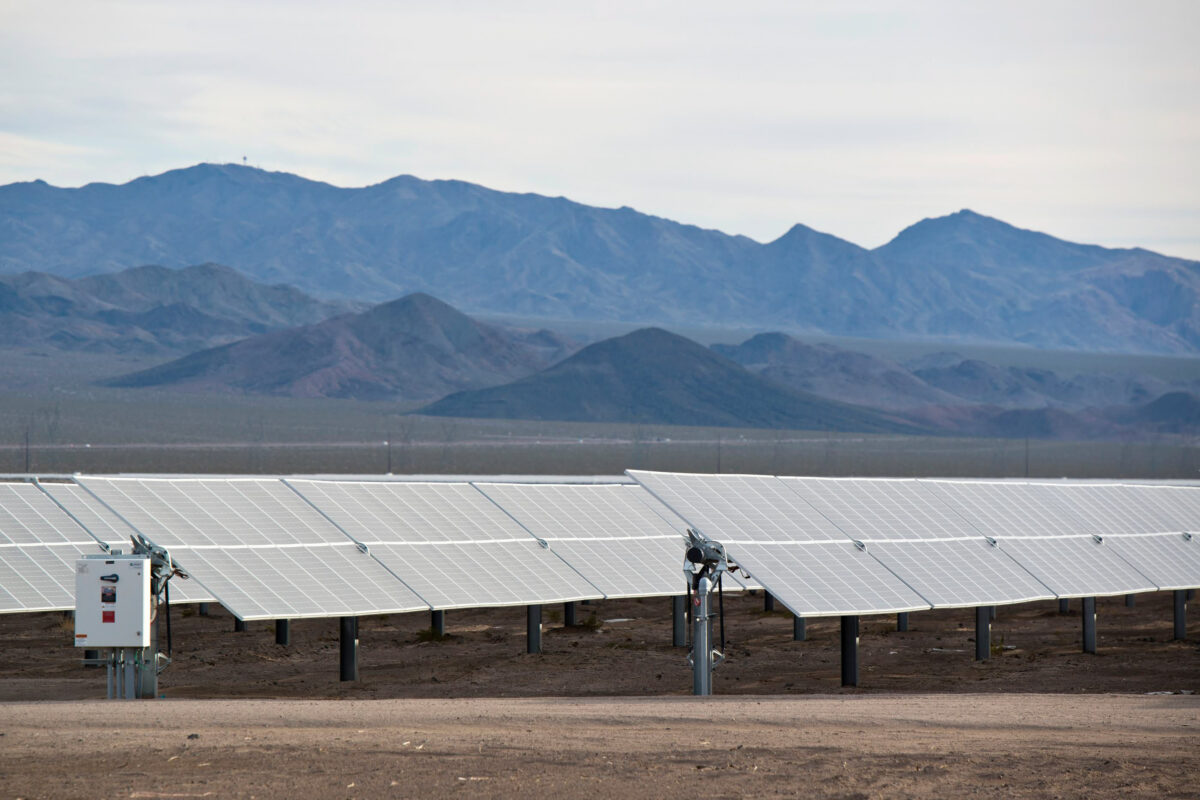As solar harvesting booms in Nevada, conservationists call for a state-specific development plan

With nearly 100 solar plant applications pending in Nevada, conservationists worry there isn’t an updated management plan specifically guiding utility-scale solar development in the Silver State.
“We are about to see another energy industrial revolution, and Nevada is at the center of that,” said Jaina Moan, Nevada external affairs director for the Nature Conservancy. “But there’s no one master plan to guide all of this development.”
There are 96 pending solar plant applications across the state, with 51 in Southern Nevada, according to Greg Helseth, renewable energy branch chief at the Nevada state office of the Bureau of Land Management.
The push for more solar comes from state and federal clean energy initiatives.
In 2019, the Nevada Legislature passed Senate Bill 358, updating the state’s renewable energy portfolio standard by requiring the state to generate 50 percent of its electricity from renewable resources by 2030 and be carbon neutral by 2050.
The following year, Congress directed the permitting of 25 gigawatts of solar, wind and geothermal production on public lands by 2025 in the Energy Act of 2020. Nationally, the BLM has permitted solar projects totaling 9 gigawatts, but only 4 gigawatts are in operation.
The Biden administration’s goal of a carbon pollution-free power sector by 2035 has “prioritized the BLM’s attention to improving the permitting process to facilitate responsible renewable energy deployment on public lands,” according to the agency.
The Department of Interior, which oversees the BLM, announced earlier this year it was building off the Energy Act of 2020 and streamlining the application process for solar projects. The effort reduces fees by about 80 percent and delivers “greater certainty for the private sector.”
And in June, the agency garnered more than $105 million from the auction of 24,000 acres in Southern Nevada’s Amargosa Desert for solar energy development, marking the highest-yielding onshore renewable energy sale in the agency’s history.
“It’s a free for all,” said Kevin Emmerich, co-founder of the nonprofit Basin and Range Watch. “There are a lot of incentives right now to put renewables all over public land and it’s created a land rush.”
The BLM is “under this huge pressure” to move solar development along while working under conflicting mandates, Moan said.
The Biden administration is pushing for an increase in clean energy production, usually on public lands, while at the same time calling for preservation of 30 percent of the nation’s land, freshwater and ocean areas by 2030.
“Those goals are not always in step with each other. They can be if we do it right, but the problem is we aren’t really doing it right,” Moan said. “We’re just going ahead with development.”
The federal government has an umbrella plan guiding utility-scale solar development (20 megawatts or more) in the West. And while agencies in neighboring states have drafted plans to lead the solar rush within their borders, Nevada hasn’t, according to Moan, Emmerich and other environmental advocates. The lack of a strategy has left conservationists battling developers and federal permitters over the siting of projects.
“The fact is, the state doesn’t have a plan,” Moan said. “And all of this development is happening now and we want them working on a plan.”

A broad plan for Western states
The BLM approved its first utility-scale solar project on public land in 2010. Two years later, the agency carved out the Western Solar Plan, a federal guideline for utility-scale solar development in sun-drenched Western states.
The plan outlines 17 zones for solar development for six states, with five zones in Nevada: Amargosa Valley, Dry Lake, Dry Lake Valley North, Millers and Gold Point.
Those designated zones in Nevada total more than 60,000 acres.
But they haven’t necessarily been fruitful over the years.
In Nevada, just one zone — Dry Lake in southeastern Nevada — has been developed. The zone has four solar projects in it. Dry Lake East has a project that hasn’t been built out yet, and Amargosa, the zone with the recent $105 million land sale, will eventually be developed.
“They have a long way to go,” Helseth said.
Of the BLM’s 96 pending solar applications, none are in solar energy zones, he added. “The problem is, they (solar energy zones) are in areas where good connection to transmission doesn’t exist.”
In late 2022, the Department of the Interior announced it is updating its Western Solar Plan. The draft environmental impact statement comes out in September.
Whether solar energy zones continue as part of the plan remains to be seen.
“We’ve had them since 2012, and I guess the question is, should they stay on the books?” Helseth asked. “That’s the question, right?”
In addition to designating the 60,000 acres of solar energy zones in Nevada, the federal government has also identified more than 9 million acres of public land as potentially appropriate for solar development in the state.
While the Western Solar Plan sets aside more than 31 million acres in Nevada as exclusion areas — for example, solar cannot be developed in the Black Rock Desert–High Rock Canyon Emigrant Trails National Conservation Area — it does not identify areas of specific environmental concern within those 9 million acres.
Strategies in other Western states
The desert southwest has some of the highest solar radiation levels in the world. As renewable energy development in the West took off, agencies in Nevada’s neighboring states drafted plans to guide developers looking to tap those resources.
In Arizona, the Restoration Design Energy Project (RDEP) was established by BLM Arizona as a “step down” from national guidelines to “focus on specific issues and areas in Arizona.”
And in California, the California Energy Commission, the California Department of Fish and Wildlife, the BLM and the U.S. Fish and Wildlife Service drafted the Desert Renewable Energy Conservation Plan (DRECP). Approved by the BLM in 2016, it sets aside hundreds of thousands of acres for renewable energy development in the Mojave and Colorado deserts while simultaneously closing millions more.
Prior to the DRECP, projects were “permitted through an agency-by-agency, project-by-project approach, which does not always allow for landscape-level considerations about where projects should be located,” according to the BLM.
Nobody got exactly what they wanted with the DRECP, said Patrick Donnelly, Great Basin director for the Center for Biological Diversity. As former executive director of a different stakeholder agency during that time, he was involved in the drafting of the plan.
“Nobody loved it,” Donnelly said. “But nobody sued over it, and in the end there’s been somewhat of a détente on solar in the California desert. Obviously, that’s not the case here (in Nevada).”
The DRECP was signed off on years ago, but, like the federally-designated solar energy zones, it also got off to a slow start. The Department of Interior just approved permitting for the first three solar projects for the DRECP in late 2021. None of the projects are operational.
BLM Nevada has never considered creating a planning document similar to the RDEP or DRECP, Helseth said, because of vast differences in the amount of public land in Nevada and how that land is laid out. The BLM manages about four times as much land in Nevada as it does in Arizona, and the Arizona land is checkerboarded. In California, officials opted to restrict solar development to the southeastern corner of the state.
Whether other states’ planning guides were successful and irrespective of differing public land allocations, Nevada conservationists lament the fact that the Silver State doesn’t have a similar plan.
“We would love something like DRECP for Nevada,” Moan said. “That would be very beneficial.”
Stephanie Klapstein, public information officer for the Nevada Governor’s Office of Energy, said in an email that the DRECP “sounds similar (though larger in scale) to Nevada’s 2020 Climate Strategy,” produced by the Nevada Division of Environmental Protection (NDEP) under former Gov. Steve Sisolak’s administration.
Earlier this year, Gov. Joe Lombardo signed an executive order outlining the state’s energy policy objectives, emphasizing a need to “pursue a balanced approach to energy use and development by utilizing all available energy and storage resources, including natural gas, solar, geothermal, hydroelectric, wind, hydrogen, energy efficiency and energy storage projects.”
Building off that executive order, the Office of Energy will focus this year on gathering data that will help develop and implement more detailed plans, Klapstein said in her email.
As part of those efforts, the 2020 Climate Strategy is under revision to better align with Lombardo’s directives, according to a spokesman for NDEP. Online access to it has been removed during that process.
Donnelly said in an email that comparing the 2020 Climate Strategy to the DRECP “is really inaccurate.” The 2020 Climate Plan takes a 10,000-foot view, he countered, and doesn’t outline criteria for locating solar projects.
“It really said very little about desert utility-scale solar at all,” he added.
Ultimately, planning for federal land must come from the federal government, according to Assemblyman Howard Watts (D-Las Vegas).
“State and local governments are definitely important stakeholders and the opinions of our elected officials and agencies are definitely taken into consideration when these decisions are made,” he told The Indy. “But ultimately when it comes to development of energy projects on public lands, those final decisions are made by federal land management agencies.”

Pausing to plan
Compounding the lack of a Nevada-specific plan is the outdated nature of localized resource management plans (RMPs), the primary tool guiding BLM activities and decisions at the regional level.
Management of nearly three-quarters of Nevada’s land is governed by RMPs, but most RMPs in the state are more than 20 years old. Some date back to the mid-1980s.
The BLM is in the process of updating its RMPs, but it will be several more years until that process is complete. The BLM is currently collecting baseline surveys needed to initiate the project, according to Rita Henderson, public affairs specialist for Nevada BLM. Those surveys will be completed over the next year and a half. After that, pending approval from BLM headquarters, a notice of intent will be published. It could take up to four years to complete the project after the notice is published.
While the RMPs are being updated, the agency doesn’t “stop one planning effort while another is going on,” Brian Buttazoni, planning and environmental specialist, said at a July meeting in Reno regarding the proposed Greenlink West transmission line. RMPs are still the guiding documents for local branches of the agency, he said, even if they are outdated.
Basin and Range Watch asked the BLM to wait to approve projects such as the Bonanza Solar Project — sited about 30 miles northwest of Las Vegas in an area the group calls on its website “the most critical desert tortoise connectivity corridor in Southern Nevada” and under federal FAST-41 designation, expediting its review and authorization process — while the RMPs are updated.
Its request went unheeded.
“We would like to see some of these projects paused while we look at what areas in Nevada should be focused more on conservation,” Emmerich said. “There are some opportunities to regulate this with the federal land use plan update.”
In a July 2022 letter to the BLM, the Nature Conservancy requested the BLM also draft plans for energy project siting and transmission infrastructure alignments in its RMP updates, stating that “this need is immediate.”
The updated RMPs will likely include solar siting and will be more “boots on the ground level” plans that fine tune the updated Western Solar Plan when it is released, Helseth said. “We can micro-adjust.”
It’s good to see those planning efforts underway, Moan said, but she, and others, want to see plans take shape even faster.
“People get afraid if you start to pause and plan that you are losing time,” she said. “But if we can steer this along a path that is less impactful from the start … that’s a win.”
